Hydrangea "Vanilla freise": description, planting, care and reproduction
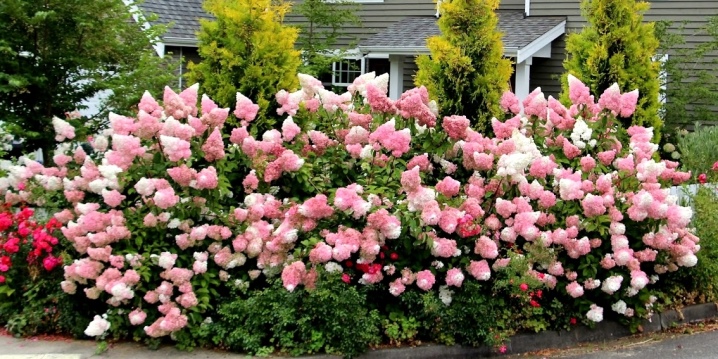
Hydrangea is very popular with Russian gardeners due to its bright and fragrant flowers. The paniculate variety "Vanilla Freyz" is especially loved. Its highlight is the change in the color of the buds during the flowering process. Luxurious appearance is combined with unpretentious content and good frost resistance. However, ease of maintenance does not mean that it is absent. To get a beautiful bush, you need to know the features of planting, reproduction and cultivation of this hydrangea variety.
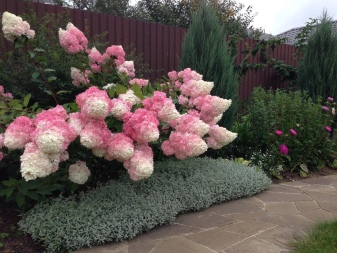

Description
Panicle hydrangea "Vanilla Freise" ("Vanilla Freise") is a perennial plant that, under favorable conditions and competent care, can live up to 50 years. The name Vanille fraise comes from two French words: the first is translated as "vanilla", and the second is "strawberry". It is the vanilla-strawberry shade that the inflorescences of the culture have. Moreover, they change color from creamy white to pale pink, and by the end of the flowering period, the caps darken and become almost crimson, while their tops remain snow-white. Considering that the buds bloom at different times, the bush is striking in a variety of shades.
The variety was created in the French nursery Renault. Work on it was carried out from 1989 to 2003. The head of this institution, Eric Reno, was involved in the development of Vanilla Freise, who received several awards for her at various exhibitions.
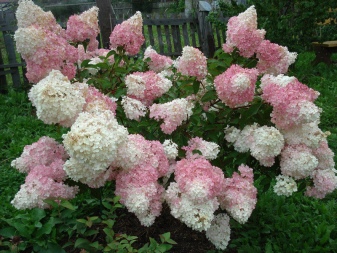
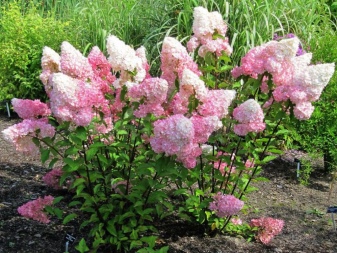
The variety impresses primarily with its beautiful, lush and long flowering. It starts in the first half of June (in some regions even at the end of May) and lasts until the end of September and the beginning of October.
Wide cone-shaped inflorescences with a sharp white top reach a length of 30 cm. The diameter of the entire crown varies from 1.5 to 2 meters. And the bush grows to a height of 200 cm.
The dark green leaves of an elongated oval shape have a rough surface with slight pubescence. Straight burgundy branches, with the appearance of a large number of blossoming buds on them, begin to bend slightly, turning the bush into a huge flowering sphere.
The root system of "Vanilla Freise" is small, but highly branched, located near the surface.
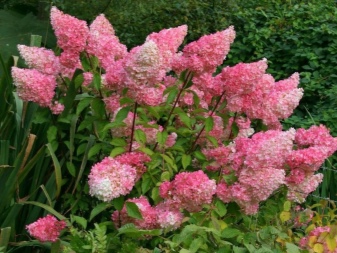
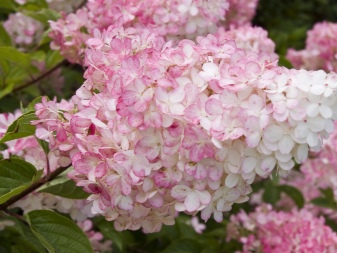
Landing
The optimal time for planting is late spring, when the snow has melted and the ground has warmed up enough. However, in the southern regions, hydrangeas can also be planted in the fall, before the onset of frost.
Although hydrangea "Vanilla Fraz" is not very demanding on the conditions of keeping and will grow in places with any light, it is still better to choose a penumbra zone for it. Under too aggressive sun, the bush takes longer and slower to form. And the lack of light will affect the appearance of the buds - they will be smaller in size and less bright and saturated in color. Ideally, the first half of the day, the hydrangea should be in the shade, and the second - under the sun, better diffused rays. When choosing a landing site, it is also worth considering the climatic zone. In the south of Russia, shady areas are preferred, and in the northern regions, hydrangea will feel better under the sun, which compensates for the lack of heat.
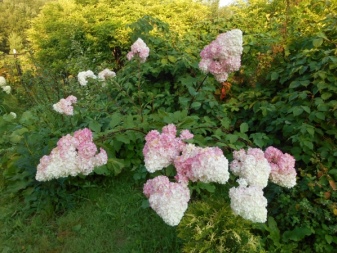
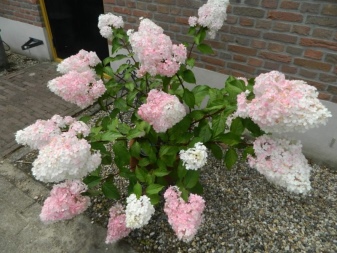
Undesirable for hydrangea is the proximity to apple, pear and other fruit trees - they will take too much water from the soil. but excess moisture is also harmful to Vanilla Freise, so choose a moderately moist planting site, and always protected from the wind.
The main requirement for the soil is that it must be fertile, loose and low acidic (for example, neutral pH). Sandy and calcareous soils are absolutely unsuitable for hydrangeas due to the lack of nutrients in them.
Before planting, the soil must be prepared - supplied with organic and mineral fertilizers. But chalk, ground limestone and ash cannot be used as top dressing.

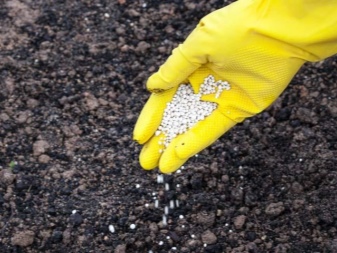
Landing algorithm.
- Dig holes 50 cm deep and 30 cm in diameter.There should be a distance of at least 1 m from one bush to another.
- So that the water in the roots does not stagnate, the bottom is lined with a layer of drainage. As such, you can use expanded clay or pebbles mixed with sand.
- Soil is poured over the drainage layer. The easiest way is to buy a ready-made hydrangea substrate. But you can prepare the soil mixture yourself by mixing peat and humus in equal proportions and adding leafy or soddy soil with sand to them.
- Fertilizers with a high content of phosphorus and potassium are applied to the wells.
- Moisten all pits generously with water. Seedlings can be planted only 10-14 days after soil preparation.
- Before planting, the sprouts are "trimmed". On each seedling, the roots are slightly pruned, and no more than 3 buds are left on the outer part of the shoot.
- The sprouts are carefully placed in the ground, straightening the roots. In this case, the root collar is left on the surface.
- Having covered the pits with soil, young plants are watered, loosened and mulched with needles or sawdust.
- Provide them with reliable protection from direct sunlight and wind.
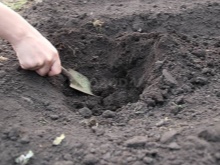
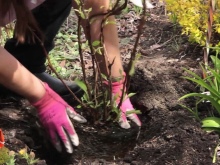
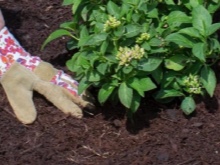
"Vanilla Freise" looks spectacular and original on a trunk.
From a bush, it turns into a tree with a long bare trunk, which is crowned with a lush bright crown. If you do not want to go the easiest way and purchase such an option in the nursery, but prefer to grow a standard hydrangea on your own, then you will have to be patient - you will need about 7 years for this. But the resulting copy will not leave anyone indifferent and will make your garden royally luxurious!
Here's the easiest way to get a Vanilla Freise stock. The stem of the cutting is tied to a wooden post dug into the ground. Each year, the side branches are removed to the most developed bud and the growing top of the plant is tied up. After the hydrangea reaches the desired height, pinch the crown of the crown.
You can also get a standard tree by grafting, but this is a more complicated and time-consuming method.
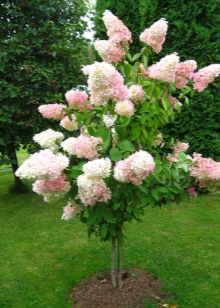
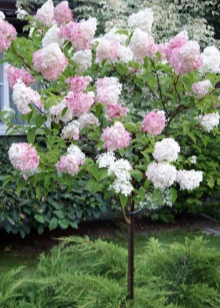
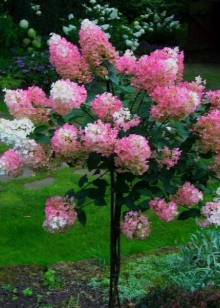
Care
The cultivation technique of "Vanilla Freise" is simple. To get a lush and beautiful bush, you just need to carry out competent watering, do regular pruning and apply the necessary fertilizers on time.
Hydrangea is very fond of water. The top layer of the soil, where the roots are located, should always remain moist - drying out of the soil will lead to the fact that the leaves begin to wilt, and the flowering will be less lush and lasting. In moderate weather, it is enough to water the flower once a week, for each bush there should be 2 buckets of water. In the heat, the frequency of watering doubles, and in the rainy period, on the contrary, the soil needs to be moistened less often.
The water should be kept warm. Water the hydrangea in the morning or evening so that the plant does not get sunburn.
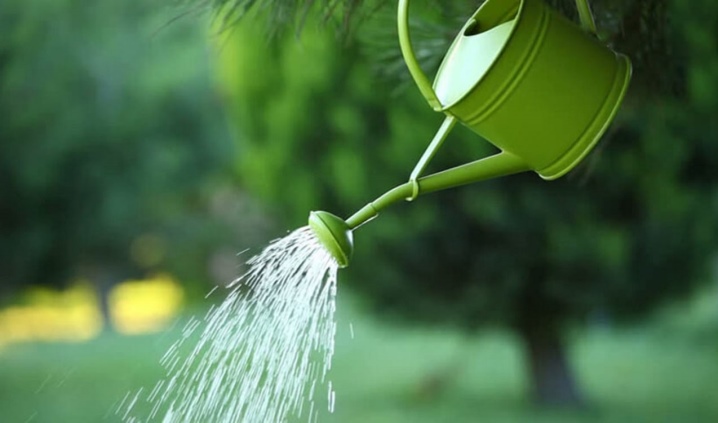
To prevent rot, you can add a few crystals of potassium permanganate to the water.
Each watering is completed by loosening and mulching the soil, adding peat, humus, pine needles or sawdust to it to retain moisture.
Pruning is carried out not only and not so much for an aesthetic purpose, so that the bush looks beautiful. The main task of this procedure is to increase the number of buds on the bush and their size, as well as accelerate the growth of hydrangeas.
Pruning is done every year.Some gardeners advise doing it in the spring, before the growing season, while others believe it is better to remove old branches and cut off the young after the bush has faded - at the end of October.
You can try both options and choose the one that suits you best.
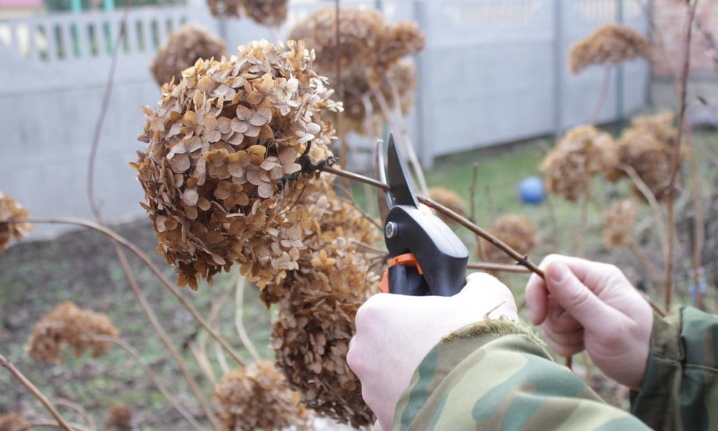
Cropping involves the following steps.
- They rid the bush of dry, broken and frost-damaged branches that interfere with the growth of healthy shoots.
- The remaining branches are simply shortened, leaving up to 3 buds on each. This will provoke the appearance of larger buds.
- Dry stems with faded buds are also removed to make room for new buds.
As a result of pruning, no more than 12 healthy and strong shoots should remain on each bush, which, with proper care (observing the watering regime and proper feeding), will give abundant flowering in the new season.
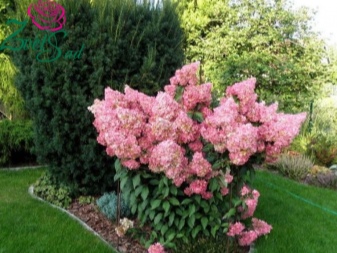
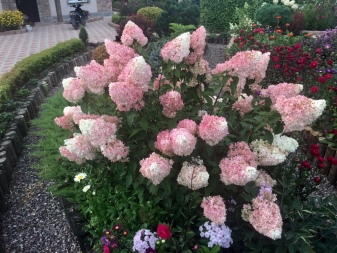
Top dressing
In order for the "Vanilla Freise" bush to delight you with lush flowering, it is necessary to provide it with all the necessary nutrients. In shops for gardeners, ready-made mineral complexes for hydrangeas are sold; preparations for azaleas or other flowering plants are also suitable. But it is better not to be limited to industrial "feed", but to add hydrangeas and organic fertilizers, for example, mullein, to the "menu". So, it is organic matter that is preferable for the very first feeding of a plant planted in open ground - it is applied after 14 days.
Further, every year the hydrangea is fertilized according to a certain scheme.
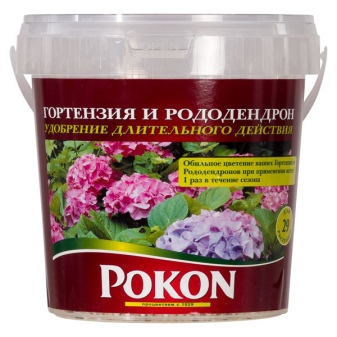
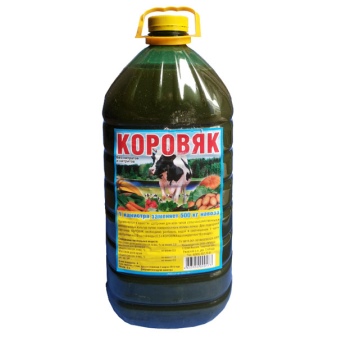
The first feeding is done in the last decade of May, when the buds begin to swell. You can use humus, mullein, or slurry as fertilizer. It is also recommended to feed the plant with nitrogen in the spring - it will stimulate the growth of new shoots.
In June, with the beginning of bud formation, we introduce fertilizers into the hydrangea's diet, containing potassium and phosphorus necessary for flowering. They can be of both organic and inorganic nature. Various herbal infusions rich in vitamins and microelements will be useful for the flower. But nitrogen cannot be given during this period - it will negatively affect the flowering process.
At the end of August, superphosphate fertilizers will become the best "food" for hydrangeas. They contain a large amount of beneficial minerals that will contribute to abundant flowering.
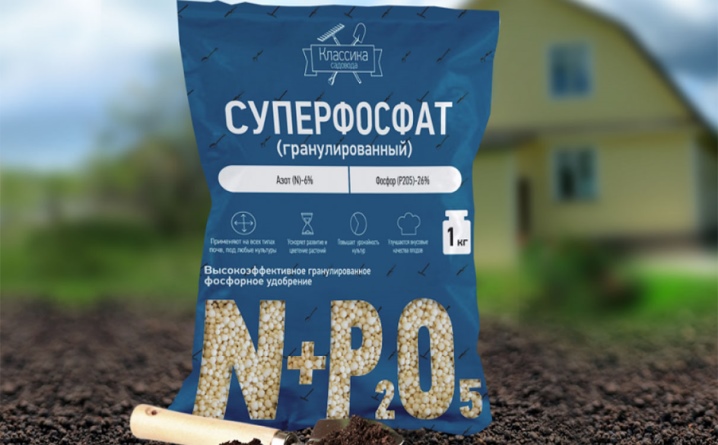
In the fall, we once again supply the soil with phosphorus fertilizers.
Though "Vanilla Fraze" is resistant to cold weather, but in the northern regions, where the temperature in winter drops below -30 degrees, it is advisable to cover the bush... Too severe frosts can lead to freezing of the shoots and, as a result, to poor flowering or even its absence. You can cover the bush with dry foliage and cover it with snow.
But for more reliable protection, it is better to use burlap or a special covering material - agrofibre or lutrasil.

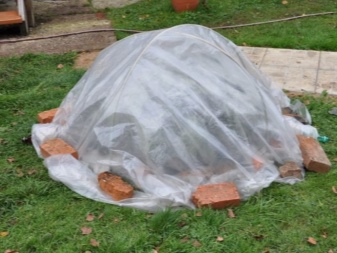
Reproduction
You can propagate vanilla hydrangea in one of the following ways.
Cuttings
The easiest way to get new plant specimens is from cuttings cut from an adult. This procedure is performed in the spring or summer, you can also use the shoots obtained after the next pruning.
Each cutting must have 2 or 3 buds. Before planting in the ground, the seedlings are placed in a solution of a biostimulator (for example, "Kornevin") for 1, 5-2 hours. Then they are planted in a garden bed or in containers filled with a mixture of peat and sand (in a ratio of 2 to 1) to a depth of 2 cm. It is better to choose a penumbra zone - direct sunlight should not fall on the sprouts. To create a greenhouse effect, young plants are covered with polyethylene or glass. This will provoke root growth.
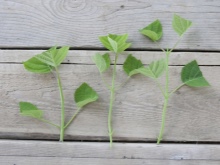
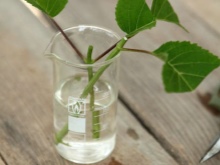
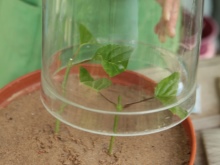
If you carry out regular watering, daily spraying and airing, then in 2-3 weeks the cuttings will take root. After that, the mini-greenhouse can be removed.However, young plants are planted in their permanent habitat only the next year; they should overwinter in a temporary “dwelling”. Therefore, for the winter, it is important for them to create good protection from the cold.
Layers
"Vanilla freise" can be propagated by layering. We remove the leaves from the lower stem of an adult plant and place it in a 15-20 cm deep hole dug next to it. We fix the shoot with brackets or hairpins and sprinkle with nutritious soil. Experienced gardeners recommend making an incision on the stem for early root formation and putting a toothpick or match there.
On the layers dug in in spring, by the end of summer - beginning of autumn, new shoots will form, which will need to be separated from the mother and transplanted into beds or pots.
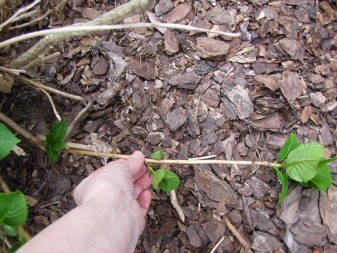
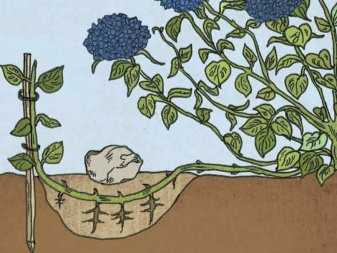
By dividing the bush
This method is best used if you are replanting an adult hydrangea to a new place - then you get several from one bush. First, carefully dig up the mother plant so as not to damage its root system. Then, with a shovel or ax, divide the bush into several parts, each of which should have healthy roots with 2 points of growth and shoots with at least 3 buds. Lubricate the cuts with powdered charcoal.
Then we plant each division in a place prepared in advance for it.
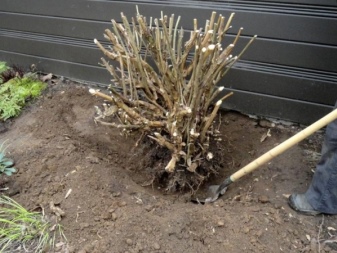

Seeds
It is not rational to reproduce "Vanilla Freyz" in this way for two reasons. First, it may take more than one year for seeds to germinate. And secondly, the varietal characteristics of a particular flower are often lost and you can get a wrong plant that you planted.
Usually, seed propagation is used in nurseries to obtain new varieties... For novice gardeners, it is better to choose another method of propagating vanilla hydrangea, any of the ones described above.
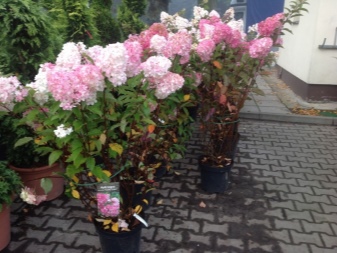
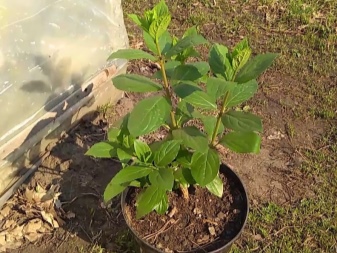
But if you nevertheless decide to experiment, then here is a seed sowing scheme.
- We prepare containers for planting: we make drainage holes in them and fill them with a fertile substrate.
- We place the seeds in the soil by 1-2 mm and water them with warm, settled water.
- We build a greenhouse from plastic wrap and put containers with future sprouts in a moderately bright place with diffused sunlight.
- Don't forget to open the seeds for airing and moisten them as needed.
- As soon as the seeds sprout, remove the greenhouse film and continue to grow the seedlings, periodically watering them.
- We transplant sprouts with a well-developed root system into open ground or separate pots.
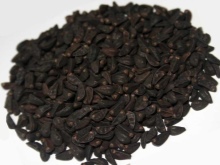
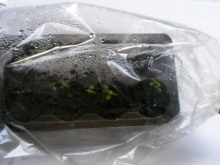
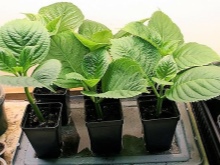
Diseases and pests
The plant is rarely attacked by garden pests. But sometimes spider mites and aphids can take a fancy to flowering shrubs. They suck out the "blood" of the plant - its nutritious sap, deprived of which, the leaves turn yellow, dry up and fall off, and the hydrangea stops growing further. With these insects, ordinary soapy water will help to cope, with which the entire bush should be treated. If this method proved to be ineffective, then the plant should be sprayed with any insecticide. Fufanon does an excellent job with a tick, and you can get rid of aphids with the help of Aktofit.
A much bigger problem for Vanilla Freis is the fungal disease that hydrangeas are prone to.
Among them, powdery mildew and downy mildew are especially distinguished. The first arises from the dryness of the soil and the oversaturation of nitrogen in it. The second disease, on the other hand, is caused by a large amount of moisture in the soil.
The reason for waterlogging can be a prolonged rainy season or too abundant irrigation - then their number and volume must be reduced.
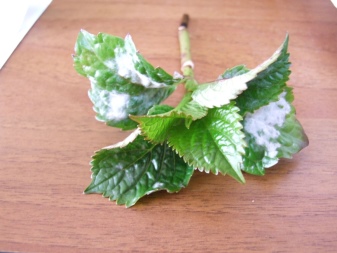
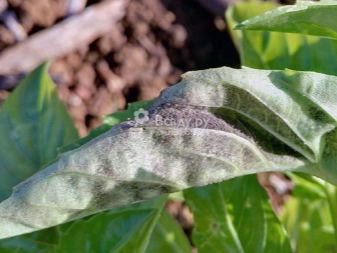
Powdery mildew infects leaves - yellow spots appear on them, which eventually turn into brown ones, and a gray cobweb appears on the seamy side of the sheet plate.
To rid the plant of powdery mildew, it is necessary to remove all damaged shoots from it, and then treat it with a fungicidal preparation, for example, Fundazol or Topaz.
Rot is another fungus that hydrangea can contract. The reason for its appearance is also an excess of moisture in the soil. Most often, flowering shrubs are affected by gray rot, from which the leaves begin to turn brown. The treatment is the same as for powdery mildew - cutting off all diseased shoots and spraying the plant with a fungicide.
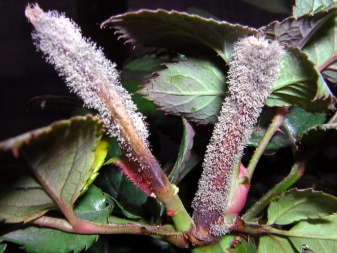
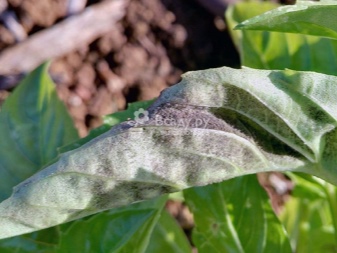
To prevent the occurrence of fungal diseases, it is necessary to carry out preventive treatments. In the spring (before flowering) and in the fall (after the buds have fallen), spray the hydrangea with the copper fungicide Hom.
Another disease that vanilla hydrangea is prone to is chlorosis. It can be caused by a lack of minerals in the soil, such as iron or nitrogen. Chlorosis also occurs from an excess of humus or lime in the soil. The disease can be recognized by a change in the color of the leaf plates: they become pale yellow, while their veins retain a rich green color. After a while, the infected leaves dry up and fall off.
Chlorosis treatment consists in increasing the acidity of the soil. To do this, you can fertilize it with peat, aluminum sulfate or treat it with an iron-containing preparation "Ferovit".
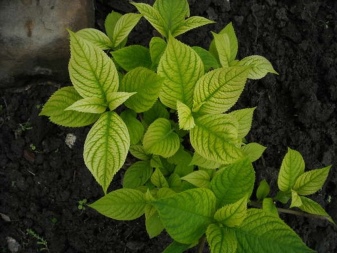
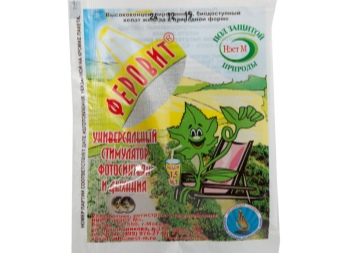
Improper conditions for keeping hydrangeas can provoke other problems.
If the plant is in direct sunlight for a long time, then it runs the risk of getting a sunburn. In this case, it must either be transplanted to a more shaded place, or an artificial shade must be created by building a shelter.
If the plant does not bloom, then there may be several reasons. The most likely are insufficiently fertile soil or freezing of inflorescences in winter.
Adding nutrients to the soil and providing good protection from the cold will help alleviate this problem.
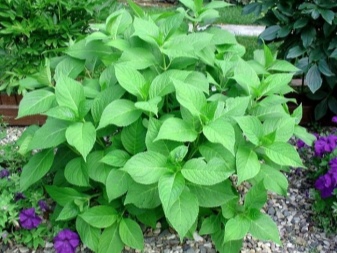
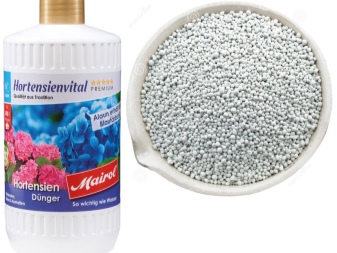
Use in landscape design
The beautiful hydrangea will be a wonderful decoration for both parks and summer cottages. You should not be limited to banal planting it in a flower bed, although in this case your garden will sparkle with new bright colors. A panicle hydrangea will look much more interesting as a hedge, planted around the perimeter of the fence, you can also surround a house or a gazebo with white and rose bushes.
Looks good "Vanilla Fraze" and alone, and in the company of other plants. The most advantageous will be its neighborhood with juniper and barberry. Cypresses, spruces, pines and other conifers also make a great backdrop for vanilla strawberry hydrangeas.
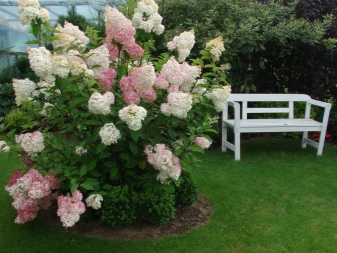
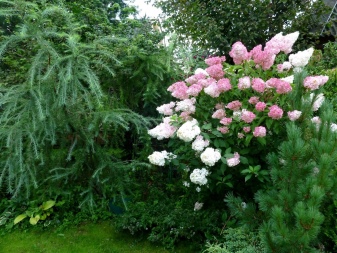
Review overview
Russian gardeners speak with admiration of Vanilla Freise.
First of all, they note her spectacular appearance: beautiful fragrant buds of an unusual color that bloom during flowering and delight the eye not only the owners themselves, but also the guests of the summer cottage. Summer residents talk about its unpretentiousness, that this hydrangea variety is easy to grow and maintain.
There is also an emphasis on the good climatic adaptability of "Vanilla Freis", and on the fact that it adapts to almost any weather conditions and easily tolerates even severe frosts (from which, nevertheless, it needs to be protected).
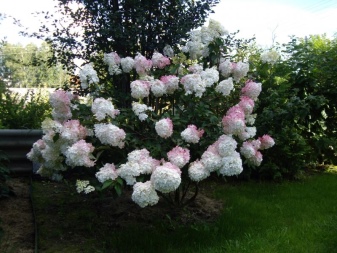
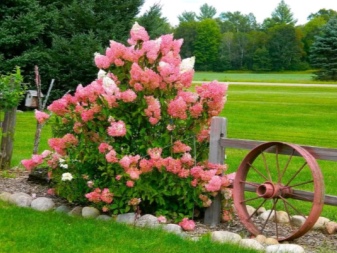
Some gardeners share the bad experience of growing this hydrangea variety. Due to the choice of an unsuitable (usually too sunny place) "Vanilla Freise" gave small flowers. However, after transplanting the bush to a shady area, the size of the buds and the duration of their flowering increased.
As you can see the magnificent Vanilla Fraze easily wins the hearts of gardeners... But she does not at all correspond to the image of a capricious beauty and does not require increased attention to herself.After spending a small amount of time caring for her, you will receive a flower that will become a decoration and pride of your summer cottage!
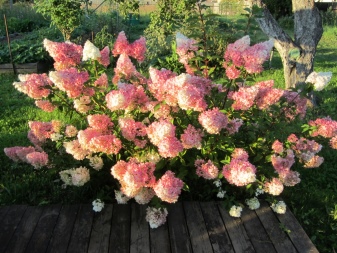
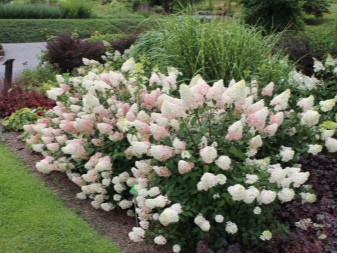
For information on how to care for the Vanilla Fraise hydrangea, see the next video.



































































The comment was sent successfully.